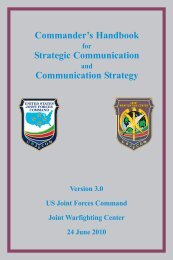A Leader's Guide to Trauma in the Unit - US Army War College
A Leader's Guide to Trauma in the Unit - US Army War College
A Leader's Guide to Trauma in the Unit - US Army War College
You also want an ePaper? Increase the reach of your titles
YUMPU automatically turns print PDFs into web optimized ePapers that Google loves.
<strong>Army</strong> <strong>War</strong> <strong>College</strong> Spouses’ Project<br />
2. There should be a Plan-of-Action <strong>in</strong> <strong>the</strong> case of <strong>the</strong> death of an active duty member.<br />
However, <strong>in</strong> <strong>the</strong> case of <strong>the</strong> death of a spouse or child, <strong>the</strong>re is no preparation — <strong>the</strong><br />
unth<strong>in</strong>kable has occurred. The better you know your unit, <strong>the</strong> family members, <strong>the</strong><br />
unit dynamics and <strong>the</strong> resources available <strong>to</strong> your <strong>in</strong>stallation, <strong>the</strong> better prepared you<br />
will be <strong>to</strong> deal with any tragedy that may befall anyone <strong>in</strong> that unit. This process<br />
beg<strong>in</strong>s from <strong>the</strong> moment you become a senior leader <strong>in</strong> <strong>the</strong> unit, not once a tragedy<br />
has occurred.<br />
3. Be sure <strong>to</strong> utilize subject matter experts <strong>in</strong> <strong>the</strong> unit cha<strong>in</strong> of command (JAG,<br />
Personnel unit, hous<strong>in</strong>g and AER) <strong>to</strong> make sure you are deal<strong>in</strong>g with <strong>the</strong> most current<br />
and accurate <strong>in</strong>formation.<br />
4. Hav<strong>in</strong>g a function<strong>in</strong>g, organized, <strong>in</strong>volved FRG will make it easier <strong>to</strong> reach out and<br />
assist a unit family that experiences <strong>the</strong> loss of a spouse or child. Below are th<strong>in</strong>gs<br />
that can be done <strong>to</strong> help <strong>the</strong> FRG render help most effectively:<br />
• Rosters and phone trees should always be current. Ensure that personnel data<br />
forms have correct <strong>in</strong>formation and <strong>in</strong>clude a physical address, not just a post<br />
office box. Practice us<strong>in</strong>g phone trees so <strong>the</strong>y are a familiar <strong>to</strong>ol for unit members.<br />
This also encourages members <strong>to</strong> have contact with one ano<strong>the</strong>r <strong>in</strong> nonemergency<br />
situations.<br />
• Identify FRG members who are will<strong>in</strong>g <strong>to</strong> assist with various needs that will<br />
likely arise <strong>in</strong> a crisis situation: provid<strong>in</strong>g meals, childcare, transportation, house<br />
sitt<strong>in</strong>g, pet sitt<strong>in</strong>g, etc.<br />
5. In advance of any tragedy, consider hold<strong>in</strong>g an FRG meet<strong>in</strong>g focused on proactive<br />
<strong>to</strong>pics such as Family SGLI, wills, liv<strong>in</strong>g wills and <strong>the</strong> availability of services offered<br />
by community resources such as ACS, Red Cross, etc. Encourage active-duty<br />
members and <strong>the</strong>ir spouses <strong>to</strong> keep <strong>the</strong>ir records (f<strong>in</strong>ancial documents; <strong>in</strong>surance<br />
policies; marriage, divorce, and birth certificates; etc.) organized and available.<br />
6. In advance of any tragedy, offer tra<strong>in</strong><strong>in</strong>g for <strong>in</strong>terested unit and FRG members on<br />
help<strong>in</strong>g <strong>in</strong> times of trauma and crisis. The unit Chapla<strong>in</strong> and/or tra<strong>in</strong>ed social workers,<br />
counselors and <strong>Army</strong> Family Team Build<strong>in</strong>g can offer this tra<strong>in</strong><strong>in</strong>g. Be familiar with<br />
support groups offered through <strong>the</strong> local community. Most medical facilities and<br />
churches offer such services.<br />
7. Develop a work<strong>in</strong>g relationship with <strong>the</strong> chapla<strong>in</strong>s and counselors on your<br />
<strong>in</strong>stallation. Familiarize yourself with what services <strong>the</strong>y can provide <strong>to</strong> families <strong>in</strong><br />
need.<br />
8. Educate yourself about pert<strong>in</strong>ent <strong>Army</strong> regulations. These can be tedious <strong>to</strong> weed<br />
through, but understand<strong>in</strong>g what <strong>the</strong> <strong>Army</strong> does and does not provide <strong>to</strong> families<br />
under <strong>the</strong>se circumstances can allow you <strong>to</strong> direct <strong>the</strong> griev<strong>in</strong>g family <strong>to</strong> appropriate<br />
________________________________________________________________________<br />
36<br />
A Leader’s <strong>Guide</strong> <strong>to</strong> <strong>Trauma</strong> <strong>in</strong> <strong>the</strong> <strong>Unit</strong> April 2004





